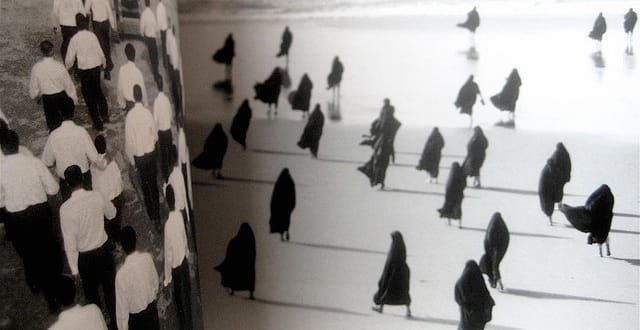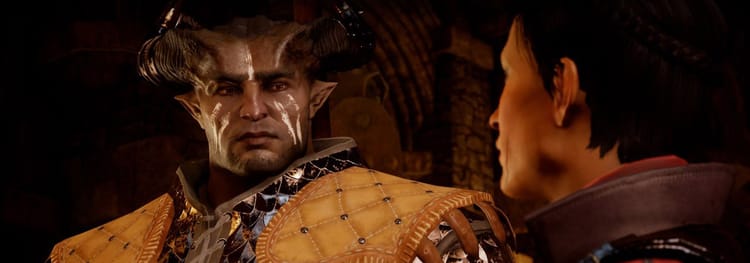Do It Differently

Everybody’s sick of this debate, but there is an interesting assumption underlying the claims made by film critic Roger Ebert and the editors of n+1 that videogames, as a matter of principle, cannot be art. Both exhibit a suspicion of the nonlinearity of videogames. The coherent whole of a linear work is opposed to the fragmentary experience of videogame play. For Ebert, “Art seeks to lead you to an inevitable conclusion, not a smorgasbord of choices.” And declaim the n+1 editors, “The beauty of an image within a story depends on its place within an irreversible narrative.”
Inevitability and irreversibility—either there’s a straight line plotted out for you by an artistic genius, or it isn’t art. Videogames cheapen experience by letting us do it again and do it differently.
The insistence on nonlinearity as a primary, almost definitional, quality of videogames has also cropped up in the form of ludology—the term proposed by Gonzalo Frasca in 1999 for the scholarly study of videogames. Like Ebert and n+1, ludologists saw nonlinearity as a central facet of games; so much so that methods developed to study linear forms such as cinema or literature actually interfered with our thinking about games. Unlike Ebert and n+1, they saw nonlinearity in a positive light, as offering a new freedom from the strictures of linear narrative.
The idea of nonlinearity also appears in popular and journalistic discussions of games: think how often a game reviewer will offhandedly use the term “linear” in a pejorative sense, whereas “replayability” and “open world” tend to reflexively get the thumbs up. The recent Mass Effect 3 ending imbroglio shows how high passions can run when it comes to linearity in games.
But does this idea that games are a uniquely nonlinear form really pass muster? For this to be the true, it would have to be the case that all art is linear: inevitable and irreversible. Each artwork would have to be a coherent and predetermined whole, rather than a fragmented ensemble we are involved in configuring ourselves. This does not seem to be the case.
There are many ways in which artworks organize temporal and spatial experience, not just two.
Look around you. Architecture is an art form—you’d be brave indeed to claim the Sistine Chapel or the Patio de los Leones are not art, and only slightly less brave to call them “linear.” Robert Venturi and Fredric Jameson didn’t have to wait for ludology to be invented so they could wrap their heads around the nonlinear spaces of Las Vegas and the Bonaventure Hotel, respectively. Similar observations could be made for sculpture or improvisational music. In these art forms the distinction between linear and nonlinear is just a nonsense. It does not even arise as a problem in the first place.
No doubt the rejoinder would be that this is too wide-ranging; that linearity is a property of narrative, and it is from narrative that videogames constitute a break. But the most ancient narratives—religious texts, enigmas, myths, legends, and fables—are hard to characterize as linear. Instead we see a myriad of variant myths, regional discrepancies, retellings, and borrowings. The Sphinx very much expected interactivity when she posed her riddle. When using a sacred text, people are much more likely to follow a liturgical calendar than read from cover to cover in a linear fashion. Furthermore, such texts are sources of living traditions of interpretation that deeply influence both the academy and the courthouse. There is also bibliomancy, the divinatory use of literary texts—Rabelais describes his scurrilous character Panurge conducting a “Virgilian lottery” by opening a copy of the Aeneid to a random verse and interpreting the contents.
OK, perhaps this is too broad again? What if we stick to our modern notions of literature; surely plays, poems, and novels have a linear structure? Not inevitably. Many canonical texts appear to us as stable fonts of wisdom, but they often come down to us fragmented and conflicted. A lot of editorial work and scholarly judiciousness goes into those “authoritative editions.” Although Ebert dutifully doffs his cap to the Bard, we do after all have multiple versions—folio and quarto—of the works of Shakespeare: we’re making a choice every time we perform or read these works, even if we bashfully delegate that choice to the editors of The Riverside Shakespeare.
The idea that games are uniquely nonlinear really falls down with respect to artists who have made nonlinearity an integral part of their work. Many people have encountered the poems of William Blake as straightforward linear texts, but the man himself would have been horrified at this. Blake created illuminated poems using an engraving technique he invented himself. He describes this in the trippy The Marriage of Heaven and Hell as “printing in the infernal method, by corrosives, which in Hell are salutary and medicinal, melting apparent surfaces away, and displaying the infinite which was hid.”
As Blake fashioned these works himself (“I must Create a system, or be enslav’d by another Man’s”), he could vary each and every one—changing coloration, emphasis, text, and image such that no one patron got the same copy of a poem. We are only now beginning to fully fathom the magnitudes and complexities of Blake’s lateral dialogue with the aid of digital technology that allows the comparison of many variant designs at once. This is no linear text, and the term nonlinear seems hopelessly inapt. In fact the linear interpretation has actively concealed an entire nonlinear dimension of Blake’s work, with which he dynamically responded to a turbulent Age of Revolutions.
Such experiments crop up across the history of literary and artistic modernity. There is no set order in which we are instructed to read Balzac’s La Comédie humaine, the novels of which are instead broken up into thematic groupings (“Scenes from Private Life,” “Philosophical Studies”). Raymond Queneau’s Hundred Thousand Billion Poems, one of the founding inspirations for the Oulipo (“Workshop for Potential Literature”) group of writers and mathematicians, is a book capable of producing 1014 sonnets. William S. Burroughs utilized a cut-up technique to compose poetry. B.S. Johnson’s The Unfortunates is a novel that comes in a box. Each chapter is bound separately, and only the first and last are specified—the others can be read in any order. And then there are Nabokov’s Pale Fire and Pynchon’s The Crying of Lot 49. If you’ve read them you’ll know I can’t say too much; if not, read them and you’ll quickly figure out why.
If we primarily think in terms of whether a text is linear or not, we neglect to think about how nonlinearity works.
Modern art can probably provide even more examples than literature. We could start with the notorious Dada exhibition where gallery-goers were provided with an axe with which to destroy the artworks. Then there are Duchamp’s readymades, Rauschenberg’s collages, Pollock’s drippings, Situationism, Fluxus, Dick Higgins’ mail art and aleatory poems, and John Giorno’s Giorno Poetry Systems and its innovative “Dial-A-Poem” service: a century of nonlinear play, which has reflections in contemporary practice.
The video installation, a leading genre of “time-based art,” uses elements of reversibility, incompleteness, and contingency to challenge the museum’s claim to present works of eternal value. In Shirin Neshat’s Rapture two projections—one featuring men and another women—are made on opposite sides of the gallery space. It is impossible to watch both. You must make a choice. Christian Marclay’s Crossfire surrounds you with cinematic and televisual clips of firearms discharging. The cacophony gradually takes on musical, rhythmic elements, but trying to take it all in is impossible. As critic Boris Groys puts it, “The whole point of visiting an exhibition of time-based art is to take a look at it and then another look and another look, but not to see it in its entirety.” Do it again; do it differently.
One last possible objection might be to say that, yes, all these examples are nonlinear, but all are at least as different from videogames as they are from each other. But this is precisely the point: If we primarily think in terms of whether a text is linear or not, we neglect to think about how nonlinearity works. It is precisely the eclecticism of the works touched on in the tiny sampling above that shows the poverty of thinking too linearly. In fact, even utilizing the terms “linear” and “nonlinear” vitiates the debate by making it seem as if there are only two kinds of objects under examination when there are in fact many. Linearity attains a normative status, while nonlinearity is simply a departure therefrom. This puts dismayingly arbitrary limits on both the creative range of artists and our ability to critique their works. There are many ways in which artworks organize temporal and spatial experience, not just two.
As such, it’s time to jettison “nonlinear” in favor of a range of more specific terms. Works can be explorable, like architecture. They can be intertextual, like Balzac’s novels, Eliot’s The Waste Land, or religious commentary. They can be incomplete, like the Venus de Milo or Robert Musil’s The Man Without Qualities. They can be aleatory like Pale Fire, recursive like The Crying of Lot 49, fragmented and divinatory like the Tarot or I Ching, recombinant like Queneau’s innumerable poems. They can be variable like Blake or Warhol’s reproductions. Creating such a vocabulary can expand our appreciation for the ways in which fragmented elements are assembled into new configurations—a limitless source of inspiration for the ongoing development of videogames.
Why not compare a videogame to an uncut film and players to editors?
Thinking past “nonlinearity” will help us to explore videogames without either overstating their novelty or foreclosing on their future. Similarly, it is time to temper the aesthetics of spectatorship with that of performance. In the case of cinema, for example, why should we confine our attention to the spectatorial audience witnessing an irreversible and inevitable narrative? Why not compare a videogame to an uncut film and players to editors? Both find a line amidst an open field of possibilities. Both provide the opportunity to do it again, and differently.
Escaping linear thinking also works the other way: games have often contained linear elements such as narratives. Rather than disregarding them out of hand, it seems more compelling to think about how such structures enter into dynamic relations with contingent elements such as those mentioned above.
In fact, this approach is not so new: in the middle of the last century, Marshall McLuhan noted that modern media forms resemble mechanized processes, placing fragmented parts into series. And even earlier, eagle-eyed Romantic poet Friedrich Schlegel wrote in the Athaneum Fragments, “many works of the ancients have become fragments. Many modern works are fragments as soon as they are written.”
Image: Shirin Neshat’s Rapture; catalogue photograph by Federico Novaro



